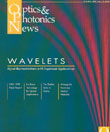
August 1993 Issue
- Ion Beam Technology For Optical Applications
- The Golden Ratio In Optics
- Prospects And Challenges For Waveguide Nonlinear Optical Materials
- Optical Drawing Standards Focus On “How,” Not “What”
- The Life And Times Of Roy G. Biv
- Wavelets Signal Representations With Important Advantages
- Browse all Issues
Feature Articles
Ion Beam Technology For Optical Applications
Ion beam technology is playing an increasingly important role in the optics industry, from low-loss high end mirrors to diamond-like coatings on sunglasses. Ion beam sputter deposition, ion beam direct deposition, ion beam assisted deposition (reactive or inert), and ion beam precleaning are processes that greatly enhance optical surfaces and materials with which they interact. Broad beam Kaufman-type ion sources are capable of performing all of these applications. A beam of inert or reactive ions is generated in a discharge chamber by a hot filament and then accelerated to a work surface.
by Colin Quinn and Peter LindemanLike the irrational numbers Π and e, the golden ratio—itself an irrational number—keeps cropping up in the most diverse fields, from architecture to zoology. It was known in many forms, although not by the name golden ratio, to the mathematicians of the school of Pythagoras, the Greek philosopher (569-500 B.C.). Perhaps the simplest source is in finding the golden cut of a straight line. If a line is cut into two lengths, 1 and x, so that (1+x)/x = x/1, then the golden cut has been made and x is known as the golden ratio. This ratio has fascinated mathematicians and others ever since, but it was not until the early part of the 20th century that the Greek letter Φ was suggested as its designation.
by Berton C. WillardProspects And Challenges For Waveguide Nonlinear Optical Materials
Nonlinear optics has emerged in the last decade from a basic science discipline that requires large, high power lasers for implementation, to a focus for a number of potential technologies in the information processing area that can be implemented with diode lasers. This rapid transition has been spurred on by two important factors. First, waveguide technology has been developed to the point that high intensities can be maintained over centimeter propagation distances with low losses in interesting (i.e., useful) nonlinear media. Second, new materials and new ways to use existing materials have both been invented. Developing these technologies to their ultimate limits can lead to (1) doublers, and parametric devices in general with sub-milliwatt input powers, and to (2) femtosecond, all-optical switching, logic, etc. devices implemented with tens of milliwatts.
by George I. StegemanOptical Drawing Standards Focus On “How,” Not “What”
Now that the new ISO 10110 Optical Drawing Standard has been sent to the ISO Secretariat for printing as an international standard and there is an ANSI/ NAPM IT.11 Committee for administering U.S. national standards, a low level debate is going on about the potential for conflicting U.S. and international optical standards. This issue is of particular concern to the parties who want to convert U.S. military standards for optics into U.S. national standards and sell them as a means of raising money to support further optical standards writing activities.
by Robert ParksThe Life And Times Of Roy G. Biv
Last year a television crew came to my town to film part of a program on color. The director had the bright idea of filming me lecturing about color to grade-school children. Never having taught pupils so young, I only reluctantly agreed to take part in this scheme. The students were carefully selected from the academic fast lane. So that I would not face a completely unknown audience, I asked to meet them while the cameramen were setting up their paraphernalia. I confessed to the students that I was at a disadvantage by not knowing what they knew about color. This prompted one of the teachers in the room to beam proudly and assert, "They know all about Roy G. Biv." "Humph," was my unguarded response, "he ought to be shot." And so, with this inauspicious beginning, I did my best to convince the students that, although Roy G. Biv might be a useful device for remembering color order, the seven letters of his name did not exhaust the gamut of colors.
by Craig F. BohrenWavelets Signal Representations With Important Advantages
The goal, of course, is to get the most for the least work. In the signal analysis and processing world, this is strongly influenced by how one chooses to represent information. In 1822, Jean-Baptiste Joseph Fourier devised an excellent way to do this: represent a signal as the sum of its frequencies. Power spectra, carrier frequencies and bandwidths, clock frequencies, brain activity frequency bands—these global characterizations provide much information in a concise manner. Some of the power of this representation begins to fade, though, when one attempts to represent information that changes its character unpredictably during the course of the signal. The standard analogy is a musical score. A global representation like the Fourier transform will tell what notes were played somewhere within the piece of music, but the timing of the notes is buried in a complicated frequency representation. A better representation, like the musical score, tells what notes were played when.
by Mark O. Freeman

![Manual probe system with needles for test of semiconductor on silicon wafer. [A. Morozov / Getty]](https://opnmedia.blob.core.windows.net/$web/opn/media/images/articles/2025/1125/departments/202511-cover-web.jpg?ext=.jpg)
![Researcher Clara Saraceno in the lab. [Image by Carsten Behler Photography]](https://opnmedia.blob.core.windows.net/$web/opn/media/images/articles/2025/1025/departments/202510-cover-web.jpg?ext=.jpg)
